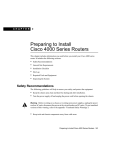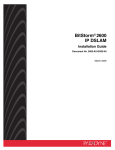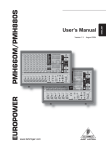Download Cisco Systems VG224 User's Manual
Transcript
C H A P T E R 3 Installing the Cisco VG224 Voice Gateway This chapter contains the procedures for installing your Cisco VG224 voice gateway and consists of the following sections: Tip • Safety Recommendations, page 3-2 • Site Log, page 3-3 • Keeping Track–Checklist, page 3-4 • Mounting Tools and Equipment, page 3-5 • Unpacking and Inspection, page 3-5 • Rack-Mounting the Chassis, page 3-6 • Wall-Mounting the Chassis, page 3-9 • Bench-Top Installation, page 3-11 • Installing the Ground Connection, page 3-11 • Connecting Cables, page 3-14 • Ports, Connectors, and Pinouts, page 3-20 • Remote Terminal Connections (If Applicable), page 3-20 • Connecting Backup Power, page 3-21 While you do this installation, record your progress and site information. See the suggested format in the “Keeping Track–Checklist” section on page 3-4. Warning Only trained and qualified personnel should be allowed to install, replace, or service this equipment. Statement 1030 Warning Read the installation instructions before connecting the system to the power source. Statement 1004 Cisco VG224 Voice Gateway Hardware Installation Guide OL-5006-04 3-1 Chapter 3 Installing the Cisco VG224 Voice Gateway Safety Recommendations Safety Recommendations The following information is included to alert you to safety recommendations and best practices when working with this equipment. Maintaining Safety with Electricity Follow these guidelines when working on equipment powered by electricity. Warning Do not work on the system or connect or disconnect cables during periods of lightning activity. Statement 1001 Warning Blank faceplates and cover panels serve three important functions: they prevent exposure to hazardous voltages and currents inside the chassis; they contain electromagnetic interference (EMI) that might disrupt other equipment; and they direct the flow of cooling air through the chassis. Do not operate the system unless all cards, faceplates, front covers, and rear covers are in place. Statement 1029 General Safety Practices Follow these guidelines to ensure personal safety and protect the equipment: Warning • Keep the chassis area clear and dust-free during and after installation. • Put the removed chassis cover in a safe place. • Keep tools away from walk areas where you and others could fall over them. • Do not wear loose clothing that could get caught in the chassis. • Wear safety glasses if you are working under any conditions that might be hazardous to your eyes. This equipment must be installed and maintained by service personnel as defined by AS/NZS 3260. Incorrectly connecting this equipment to a general-purpose outlet could be hazardous. The telecommunications lines must be disconnected 1) before unplugging the main power connector or 2) while the housing is open, or both. Statement 1043 Safety Tips Use these tips as safety guidelines when installing or working around this equipment. • Locate the emergency power-off switch for the room in which you are working. Then, if an electrical accident occurs, you can act quickly to turn off the power. • Disconnect all power before installing or removing a chassis. • Do not work alone if potentially hazardous conditions exist. • Never assume that power is disconnected from a circuit. Always check. Cisco VG224 Voice Gateway Hardware Installation Guide 3-2 OL-5006-04 Chapter 3 Installing the Cisco VG224 Voice Gateway Site Log • Look carefully for possible hazards in your work area, such as moist floors, ungrounded power extension cables, and missing safety grounds. • If an electrical accident occurs, proceed as follows: – Use caution; do not become a victim yourself. – Turn off power to the system. – If possible, send another person to get medical aid. Otherwise, assess the condition of the victim and then call for help. – Determine if the person needs rescue breathing or external cardiac compressions; then take appropriate action. Preventing Electrostatic Discharge Damage Electrostatic discharge (ESD) can damage equipment and impair electrical circuitry. ESD occurs when electronic components are improperly handled; it can result in complete or intermittent failures. Always follow ESD-prevention procedures when removing and replacing components. Caution • Ensure that the chassis is electrically connected to earth ground. • Wear an ESD-preventive wrist strap, ensuring that it makes good skin contact. • Connect the clip to the ESD-strap connection jack (to the left of the power switch on the rear of the chassis) or to an unpainted chassis frame surface. For safety, periodically check the resistance value of the antistatic strap, which should be between 1 and 10 megohm (Mohm). Site Log We recommend that you maintain a Site Log to record all actions relevant to the system. Site Log entries might include the following: • Installation—Print a copy of the Installation Checklist and insert it into the Site Log. • Upgrades and maintenance—Use the Site Log to record ongoing maintenance and expansion history. Update the Site Log to reflect the following: – Configuration changes – Maintenance schedules, requirements, and procedures performed – Comments, notes, and problems – Changes and updates to Cisco IOS software Cisco VG224 Voice Gateway Hardware Installation Guide OL-5006-04 3-3 Chapter 3 Installing the Cisco VG224 Voice Gateway Keeping Track–Checklist Keeping Track–Checklist We recommend that you use an installation checklist and maintain a Site Log. Installation Checklist The Installation Checklist (see Figure 3-1) lists the tasks for installing a Cisco VG224 voice gateway. Print a copy of this checklist and mark the entries as you complete each task. For each Cisco VG224 voice gateway, include a copy of the checklist in your Site Log. Figure 3-1 Installation Checklist Installation Checklist for site ______________________________________________ Cisco VG name/serial number _____________________________________________ Task Verified by Date Background information placed in Site Log Environmental specifications verified Site power voltages verified Installation site prepower check completed Required tools available Additional equipment available Cisco VG received Quick start guide received Regulatory compliance and safety information received Information packet, warranty card, and Cisco.com card received Software version verified Rack, desktop, or wall-mounting of chassis completed Initial electrical connections established ASCII terminal attached to console port Modem attached to console port (for remote configuration) Signal distance limits verified Startup sequence steps completed Initial operation verified Cisco VG224 Voice Gateway Hardware Installation Guide 3-4 OL-5006-04 Chapter 3 Installing the Cisco VG224 Voice Gateway Mounting Tools and Equipment Mounting Tools and Equipment Obtain the following tools and parts to install a Cisco VG224 voice gateway: • Standard flat-blade screwdriver as required for attaching brackets to rack or wall • Phillips screwdriver for attaching brackets to a Cisco VG224 voice gateway • Mounting brackets and screws for 24-inch rack, if required – Four telco machine screws, for installing the chassis in a rack (use the screw size required by the rack) • Screws and anchors for wall-mounting, if required – Eight wood screws or other fasteners, for installing the chassis on a wall. An additional starter screw can be used to facilitate wall-mounting. • ESD-preventive wrist strap In addition, you might need the following external equipment: • Console terminal, or personal computer with terminal emulation software • PC running terminal emulation software for administrative access • Modem for remote access • Analog voice RJ-21 cable • Ethernet switch • Modem for remote configuration Unpacking and Inspection Do not unpack the Cisco VG224 until you are ready to install it. If the installation site is not ready, keep the chassis in its shipping container to prevent accidental damage. The Cisco VG224, cables, printed publications, and any optional equipment you ordered might be shipped in more than one container. When you unpack each shipping container, check the packing list to ensure that you received all the following items: • Cisco VG224 • Power cord, 6-foot (1.8-meter) • RJ-45-to-DB-25 adapter cable (labeled Console) • RJ-45-to-DB-9 adapter cable (labeled Auxiliary) • Rack-mounting brackets for 19-inch rack (one pair) with screws for attaching to chassis • Chassis guard for wall-mounting applications • Grounding lug and fasteners • Cisco VG224 Voice Gateway Quick Start Guide • Cisco VG224 Voice Gateway Regulatory Compliance and Safety Information Inspect all items for shipping damage. If anything appears damaged, or if you encounter problems when installing or configuring your system, contact a customer service representative. (See the “Obtaining Technical Assistance” section on page xvi.) Cisco VG224 Voice Gateway Hardware Installation Guide OL-5006-04 3-5 Chapter 3 Installing the Cisco VG224 Voice Gateway Rack-Mounting the Chassis Rack-Mounting the Chassis Your chassis ships with a pair of brackets for use with a 19-inch rack or mounting on the wall. The bracket is shown in Figure 3-2. Quick Mounting Bracket 88815 Figure 3-2 Mounting Screws Two sets of mounting screws are provided, in separate packages. Take care to use each screw type, and washers as needed, in the appropriate locations. Table 3-1 clarifies the differences between rack-mounting and wall-mounting screws. Table 3-1 Rack-Mounting Versus Wall-Mounting Screws Rack-mounting Wall-mounting • Eight countersunk Phillips head screws (four per bracket) • Four 6–32 slotted hex screws (two per bracket) and four plastic washers • Washers are not required • Washers are required Cisco VG224 Voice Gateway Hardware Installation Guide 3-6 OL-5006-04 Chapter 3 Installing the Cisco VG224 Voice Gateway Rack-Mounting the Chassis Attaching the Brackets To install the chassis in a rack with the front panel forward, attach the brackets as shown in Figure 3-3. 19-Inch Rack Installation—Front Panel Forward 95915 Figure 3-3 CISCO VG 224 To install the chassis in a rack with the rear panel forward, attach the brackets as shown in Figure 3-4. 19-Inch Rack Installation—Rear Panel Forward 95916 Figure 3-4 VG224-24 FXS To install the chassis in a center-mount telco rack, attach the brackets as shown in Figure 3-5. Telco 19-Inch Rack Installation—Rear Panel Forward 95917 Figure 3-5 VG224-24 FXS Cisco VG224 Voice Gateway Hardware Installation Guide OL-5006-04 3-7 Chapter 3 Installing the Cisco VG224 Voice Gateway Rack-Mounting the Chassis Installing the Cisco VG224 Voice Gateway in a Rack The following warning applies only when the unit is rack-mounted: Warning To prevent bodily injury when mounting or servicing this unit in a rack, you must take special precautions to ensure that the system remains stable. The following guidelines are provided to ensure your safety: This unit should be mounted at the bottom of the rack if it is the only unit in the rack. When mounting this unit in a partially filled rack, load the rack from the bottom to the top with the heaviest component at the bottom of the rack. If the rack is provided with stabilizing devices, install the stabilizers before mounting or servicing the unit in the rack. Statement 1006 To rack-mount the chassis, follow this procedure: Step 1 Caution Choose one of the methods shown in Figure 3-3 on page 3-7, Figure 3-4 on page 3-7, or Figure 3-5 on page 3-7, and attach the long leg of the mounting brackets to the chassis, as shown. Make sure to use the correct screws for this mounting option (see Table 3-1 on page 3-6). Screws are included for attaching the brackets to the chassis, but not for installing the chassis in a rack or on a wall. You need four additional machine screws to install the chassis in a rack. Use the screw size required by your rack. After the brackets are secured to the chassis, you can rack-mount the chassis. Step 2 Using screws that you provide, attach the chassis to the rack as shown in Figure 3-6 on page 3-8. Figure 3-6 Attaching the Chassis to the 19-Inch Rack 103039 VG224 Cisco VG224 Voice Gateway Hardware Installation Guide 3-8 OL-5006-04 Chapter 3 Installing the Cisco VG224 Voice Gateway Wall-Mounting the Chassis Wall-Mounting the Chassis The following warning applies only when the unit is wall-mounted: Warning This unit is intended to be mounted on a wall. Please read the wall-mounting instructions carefully before beginning installation. Failure to use the correct hardware or to follow the correct procedures could result in a hazardous situation to people and damage to the system. Statement 248 Caution You can wall-mount the unit with either the right or left side facing up; however, the front and rear panels must be vertical. Note For information about obtaining the chassis guard, refer to field notice number 28655, VG224 Chassis Guard - Safety Regulation, at http://www-tac.cisco.com/Support_Library/field_alerts/fn28655.html. To wall-mount the chassis, follow this procedure: Step 1 Caution Attach the short leg of one bracket to the chassis, as shown in Figure 3-7, using two 6-32 x 1/4 slotted hex screws (provided). Be sure to use a plastic washer (provided) with each screw; the narrow end of the washer must fit into the bracket slot, facing the chassis. Be sure to use the correct screws and plastic washers for this mounting option. (See Table 3-1 on page 3-6.) Attaching the Brackets for Wall-Mounting 88843 Figure 3-7 Step 2 Attach the second bracket to the opposite side of the chassis. Step 3 Attach the router to the wall using the brackets previously attached and attachment hardware that you provide as follows: • You can install a starter screw in the wall, and hook the bracket keyhole over the screw. This holds the unit in place for easy installation of the attachment screws. • Attach both brackets to the wall. Cisco VG224 Voice Gateway Hardware Installation Guide OL-5006-04 3-9 Chapter 3 Installing the Cisco VG224 Voice Gateway Wall-Mounting the Chassis Note For attaching to a wall stud, each bracket requires two #10 wood screws (round- or pan-head) with #10 washers, or two #10 washer-head screws. The screws must be long enough to penetrate at least 3/4 inch (20 mm) into supporting wood or metal wall stud. Note For hollow-wall mounting, each bracket requires two wall anchors with washers. Wall anchors and washers must be size #10. Figure 3-8 shows the orientation required for installation. • Figure 3-8 Wall-Mounting the Chassis 3 1 2 103517 CISCO IAD2400 SERIES 4 Cisco VG224 Voice Gateway Hardware Installation Guide 3-10 OL-5006-04 Chapter 3 Installing the Cisco VG224 Voice Gateway Bench-Top Installation 1 Wall 3 Wall stud 2 Bracket 4 Keyhole for starter screw Bench-Top Installation Step 1 Caution Verify that there is a suitable AC power outlet available. Do not plug this unit into an AC outlet that does not have a UL-certified receptacle that is properly tied into building ground. Step 2 Place the four rubber feet (from the accessory kit) in the four indentations on the underside of the chassis.This helps provide proper airflow through and around the chassis. Step 3 Place the Cisco VG224 voice gateway on a smooth, flat surface. Caution Do not place anything on top of the chassis that weighs more than 10 lb (4.5 kg). Excessive weight on top can damage the chassis. Installing the Ground Connection Warning This equipment must be grounded. Never defeat the ground conductor or operate the equipment in the absence of a suitably installed ground conductor. Contact the appropriate electrical inspection authority or an electrician if you are uncertain that suitable grounding is available. Statement 1024 Warning AC connected units must have a permanent ground connection in addition to the power cable ground wire. NEBS-compliant grounding satisfies this requirement. Statement 284 Warning Use copper conductors only. Statement 1025 You must connect the chassis to a reliable earth ground; the ground wire must be installed in accordance with local electrical safety standards. • For NEBS-compliant grounding, use size AWG 6 (13 mm2) wire and the ground lug provided in the accessory kit. • For NEC-compliant grounding, use size AWG 14 (2 mm2) or larger wire and an appropriate user-supplied ring terminal. Cisco VG224 Voice Gateway Hardware Installation Guide OL-5006-04 3-11 Chapter 3 Installing the Cisco VG224 Voice Gateway Installing the Ground Connection • For EN/IEC 60950-compliant grounding, use size AWG 18 (1 mm2) or larger wire and an appropriate user-supplied ring terminal. To ground the chassis, follow this procedure: Step 1 Tip Locate a suitable ground location. Use a multimeter to measure the resistance between various ground locations, such as the following: • Between the ground of a junction box (outlet) and the ground of a power tap • Between the ground of a junction box and a metal water pipe • Between the Cisco VG224 voice gateway chassis and the ground of a power tap • Between the Cisco VG224 voice gateway chassis and the ground of a junction box A good ground connection should read between 0.0 and 0.5 ohms. Step 2 Step 3 Strip one end of the ground wire to the length required for the ground lug or terminal. • For the NEBS ground lug—approximately 0.75 in. (20 mm) • For user-provided ring terminal—as required Crimp the ground wire to the ground lug or ring terminal, using a crimp tool of the appropriate size. (See Figure 3-9.) Crimping a Ground Lug onto the Ground Wire 10360 Figure 3-9 Step 4 Note Step 5 Attach the ground lug or ring terminal to the chassis as shown in Figure 3-10 or Figure 3-11. For the ground lug, use the two screws with captive locking washers provided. For a ring terminal, use one of the screws provided. Use a number 2 Phillips screwdriver, and tighten the screws to a torque of 8 to 10 in-lb (0.9 to 1.1 N-m). You can orient the crimped end of the ground lug in either direction (right or left). Connect the other end of the ground wire to a grounding point at your site. Cisco VG224 Voice Gateway Hardware Installation Guide 3-12 OL-5006-04 Chapter 3 Installing the Cisco VG224 Voice Gateway Installing the Ground Connection Figure 3-10 NEBS-Compliant Chassis Ground Connection Using Ground Lug VG224-24 FXS 95919 Ground lug Figure 3-11 Chassis Ground Connection Using Ring Terminal VG224-24 103513 FXS Ring terminal attachment Cisco VG224 Voice Gateway Hardware Installation Guide OL-5006-04 3-13 Chapter 3 Installing the Cisco VG224 Voice Gateway Connecting Cables Connecting Cables For cables not included with your Cisco VG224 voice gateway, pinout information is in Appendix A, “Cable Specifications and Information.” Cisco VG224 voice gateway ports are color-coded for identification. Warning Do not work on the system or connect or disconnect cables during periods of lightning activity. Statement 1001 Warning This product relies on the building’s installation for short-circuit (overcurrent) protection. Ensure that the protective device is rated not greater than: 120 VAC, 15A (240 VAC, 10A international) Statement 1005 Warning To prevent accidental discharge in the event of a power line cross, route on-premise wiring away from power cables and off-premise wiring, or use a grounded shield to separate the on-premise wiring from the power cables and off-premise wiring. A power line cross is an event, such as a lightning strike, that causes a power surge. Off-premise wiring is designed to withstand power line crosses. On-premise wiring is protected from power line crosses by a device that provides overcurrent and overvoltage protection. Nevertheless, if the on-premise wiring is in close proximity to, or not shielded from, the off-premise wiring or power cables during a lightning strike or power surge, the on-premise wiring can carry a dangerous discharge to the attached interface, equipment, and nearby personnel. Statement 338 Table 3-2 shows the results of the NEBS Type 1/3 power cross tests (tip/ring to ground) performed on the Cisco VG224 voice gateway FXS ports. Table 3-2 Note Results of the NEBS Power Cross Tests on FXS Ports NEBS Tests Results 50 V/0.33 A; 15 minutes Pass 100 V/0.17 A; 15 minutes Pass 200 V/1.00 A; 1–second pulses, 60 repetitions Pass The installation must comply with all applicable codes. Cisco VG224 Voice Gateway Hardware Installation Guide 3-14 OL-5006-04 Chapter 3 Installing the Cisco VG224 Voice Gateway Connecting Cables LAN and Power Cables These cables and connections are described in Table 3-3 and in Figure 3-12. Table 3-3 LAN, Administrative Access, and Power Cable Selection Port or Connection Color or Type Connected To Cable Fast Ethernet Yellow Fast Ethernet switch Straight-through Fast Ethernet cable (not included) Console Light blue PC or ASCII terminal communication (COM) port RJ-45-to-DB9 console cable (included) Auxiliary Black Modem for remote access RJ-45-to-DB25 auxiliary cable (included) Power (not shown) Power 100–240 VAC, 50–60 Hz Grounding power cord (included)1 1. Power cables vary to meet local requirements. Figure 3-12 LAN and Administrative Access Connections 3 1 2 Cisco VG224 VG224-24 95920 FXS 4 5 6 Ethernet hub Modem PC 1 Fast Ethernet port 4 Fast Ethernet (straight-through) 2 Console port 5 RJ-45-to-DB9 console cable 3 AUX port 6 RJ-45-to-DB25 auxiliary cable Cisco VG224 Voice Gateway Hardware Installation Guide OL-5006-04 3-15 Chapter 3 Installing the Cisco VG224 Voice Gateway Connecting Cables Connecting the Input Power Caution The Cisco VG224 voice gateway chassis provides inputs for both AC and DC power. Design your installation to use only one type of power. Do not use AC and DC power at the same time. If you do, the unit stops operating, and you need to reboot it with only a single power source. Cable Use the AC power cable. Procedure Step 1 Connect the AC power cable (supplied) to the recessed power plug on the rear of the concentrator. Step 2 Plug the cable into a power source with a voltage of 100 to 240 VAC. Connecting the Console Port to a PC or an ASCII Terminal Use the procedure in this section to connect the console port to a PC running terminal emulation software. Note The console port does not support hardware flow control. Cable Use an RJ-45-to-RJ-DB-9 console cable (see item 5 in Figure 3-12 on page 3-15) For pinouts, see Table A-1 on page A-3 and Table A-2 on page A-4 in Appendix A, “Cable Specifications and Information.” Procedure Step 1 Configure the terminal emulation software requirements: 9600 baud 8 data bits 1 stop bit no parity no flow control Cisco VG224 Voice Gateway Hardware Installation Guide 3-16 OL-5006-04 Chapter 3 Installing the Cisco VG224 Voice Gateway Connecting Cables Connecting the Auxiliary Port to a Modem Use the procedure in this section to connect the auxiliary port to a modem. Cable Use an RJ-45-to-DB25 auxiliary cable (labeled Modem). For pinouts, see Table A-3 on page A-5 and Table A-4 on page A-5 in Appendix A, “Cable Specifications and Information.” Procedure Step 1 Connect the cable from the auxiliary port (black) to the DB-25 port on the modem. (See item 6 in Figure 3-12 on page 3-15.) Step 2 Configure the modem. Note a. Match the transmission speed of the auxiliary port (default is 9600 baud). b. Set the hardware flow control for Data Carrier Detect (DCD) and Data Terminal Ready (DTR) operation. The baud rate for the auxiliary (and console) port can be configured in software for 1200, 2400, 4800, 19200, 38400, 57600, and 115200. Connecting the Fast Ethernet Port to the Fast Ethernet Switch Use the procedure in this section to connect a Fast Ethernet port to the Fast Ethernet switch. Cable Use a straight-through Fast Ethernet cable (not included). Procedure Step 1 Connect the cable from a Fast Ethernet port to an available port on the Fast Ethernet switch. (See item 4 in Figure 3-12 on page 3-15.) Step 2 Connect the second cable if it is required. Note Not all models have two ports. Cisco VG224 Voice Gateway Hardware Installation Guide OL-5006-04 3-17 Chapter 3 Installing the Cisco VG224 Voice Gateway Connecting Cables Voice Cables Warning For connections outside the building where the equipment is installed, the following ports must be connected through an approved network termination unit with integral circuit protection. FXS/T3/E3 Statement 1044 Warning This equipment contains a ring signal generator (ringer), which is a source of hazardous voltage. Do not touch the RJ-11 (phone) port wires (conductors), the conductors of a cable connected to the RJ-11 port, or the associated circuit-board when the ringer is active. The ringer is activated by an incoming call. Statement 1042 The analog FXS voice cables and connections are: Color or Type Connected To Cable RJ-21 Distribution panel RJ-21-to-RJ-21 straight-through cable (not included) Figure 3-13 WAN and Voice Connections Distribution panel 1 Cisco VG224 VG224-24 95921 FXS 2 Network demarcation 1 RJ-21 cable 2 RJ-45 cable (through a patch panel) to central office Cisco VG224 Voice Gateway Hardware Installation Guide 3-18 OL-5006-04 Chapter 3 Installing the Cisco VG224 Voice Gateway Connecting Cables Connecting the Analog Voice Interface to a Distribution Panel To connect the multiport analog voice interface to a distribution panel, which connects to telephones, faxes, or analog PBX equipment, use the following procedure. (See Figure 3-14.) Cable Use an RJ-21 cable with Amphenol 50-pin connectors (not included). For RJ-21X/CA21A pinouts, see Table A-5 on page A-6 in Appendix A, “Cable Specifications and Information.” Warning This equipment contains a ring signal generator (ringer), which is a source of hazardous voltage. Do not touch the RJ-11 (phone) port wires (conductors), the conductors of a cable connected to the RJ-11 port, or the associated circuit-board when the ringer is active. The ringer is activated by an incoming call. Statement 1042 Procedure Step 1 Connect the RJ-21 cable from the analog voice multiport to the distribution panel. Step 2 Secure the cable in place using the strap. Figure 3-14 Analog Voice Connection 4FXS 103118 VG224-2 Distribution panel RJ-21 cable Cisco VG224 Voice Gateway Hardware Installation Guide OL-5006-04 3-19 Chapter 3 Installing the Cisco VG224 Voice Gateway Ports, Connectors, and Pinouts Ports, Connectors, and Pinouts Table 3-4 summarizes the cable connections between Cisco VG224 voice gateway and the network and user interfaces. Find the port and the equipment or network type in the table; then look at the applicable pinout table in Appendix A, “Cable Specifications and Information.” Table 3-4 Cable Use Reference Table Cisco VG224 Port Port Color Connector/Cable Interface To Pinout Information Console Light blue RJ-45/Rollover PC Table A-1 ASCII terminal Table A-2 Auxiliary Black RJ-45/Rollover Modem Table A-3 Fast Ethernet Yellow RJ-45/Fast Ethernet LAN Table A-5 Analog voice multiport Gray RJ-21X/ 50-conductor Distribution panel for analog telephone, fax, PBX, or central office line Table A-5 Remote Terminal Connections (If Applicable) If you are configuring a Cisco VG224 voice gateway from a remote location, connect the modem and the remote PC or terminal to the telephone network as described in this section. Connecting to a Modem To connect the local modem and the remote modem to live telephone outlets, use standard telephone cables. Connecting to a Remote PC To link a Cisco VG224 voice gateway to a remote PC, use the following procedure: Note The remote PC must be running terminal emulation software. Step 1 Connect the remote PC and modem. Step 2 Set the PC terminal emulation software requirements: 9600 baud 8 data bits 1 stop bit no parity no flow control. Step 3 Key in and dial the telephone number of the Cisco VG224 voice gateway external modem. Cisco VG224 Voice Gateway Hardware Installation Guide 3-20 OL-5006-04 Chapter 3 Installing the Cisco VG224 Voice Gateway Connecting Backup Power Connecting to a Remote ASCII Terminal To link a Cisco VG224 voice gateway to a remote ASCII terminal, such as a VT100, use the following procedure: Step 1 Connect the remote ASCII terminal and modem. Step 2 Set the terminal requirements: 9600 baud 8 data bits 1 stop bit no parity no flow control. Step 3 Key in the telephone number of the Cisco VG224 voice gateway external modem, or, if you are using a Hayes-compatible modem, enter ATDT and the number to be dialed. Connecting Backup Power A Cisco VG224 voice gateway can be installed with optional backup power. Backup power to a DC-powered chassis is provided by a 12-volt battery backup system; see the “Connecting a Backup Battery to a DC-Powered Cisco VG224” section for connection instructions. Backup power to an AC-powered chassis is provided by an uninterruptible power supply (UPS); see the “Connecting a UPS to an AC-Powered Cisco VG224” section for connection instructions. Caution The Cisco VG224 chassis provides inputs for both AC and DC power. Design your installation to use only one type of power. Do not use AC and DC power at the same time. If you do, the unit stops operating, and you must reboot it with only a single power source. The maximum power requirement for the Cisco VG224 voice gateway is 70 W. Connecting a Backup Battery to a DC-Powered Cisco VG224 Connect a 12-volt backup battery to the DC input connector on your Cisco VG224 voice gateway. Before you install a backup battery, be sure to read the installation instructions for the backup battery equipment. Figure 3-15 shows a setup using an external backup battery. Note Figure 3-15 shows one possible setup; please review your backup battery documents before setting up your system. Cisco VG224 Voice Gateway Hardware Installation Guide OL-5006-04 3-21 Chapter 3 Installing the Cisco VG224 Voice Gateway Connecting Backup Power Figure 3-15 Connecting a Battery Backup to a DC-Powered Cisco VG224 Cisco VG224 voice gateway AC wall plug Battery backup XS 103120 VG224-24F DC plug Caution Note Use a backup battery only if you are not using AC to power your Cisco VG224 voice gateway. Do not use AC and DC power at the same time. If you do, the unit stops operating, and you need to reboot it with only a single power source. We recommend a 12-volt automotive battery if you require longer periods of battery backup (up to 8 hours). Figure 3-16 shows the DC power connector. See Table 3-5 for pinout information for the DC power connector on the Cisco VG224 voice gateway. Table 3-5 Pinouts for DC Power Connector Pin Number Descriptions Pin Number Descriptions 1 GND (input enable) 5 ON_BAT (battery is on) 2 +12V (power) 6 +12V (power) 3 REP_BAT (replace battery) 7 LOW_BAT (battery is low) 4 GND (power return) 8 GND (power return) Figure 3-16 DC Power Connector VG224-24 103121 FXS Pin 5 Pin 1 Cisco VG224 Voice Gateway Hardware Installation Guide 3-22 OL-5006-04 Chapter 3 Installing the Cisco VG224 Voice Gateway Connecting Backup Power Connecting a UPS to an AC-Powered Cisco VG224 Connect an uninterruptible power supply to the AC input on your Cisco VG224 voice gateway. Before you install a UPS, be sure to read the installation instructions for the UPS. Figure 3-17 shows a setup using a UPS. Note Figure 3-17 shows one possible setup; please review your UPS documents before setting up your system. Figure 3-17 Connecting a UPS to an AC-Powered Cisco VG224 Cisco VG224 voice gateway AC wall plug UPS AC plug 103119 VG224-24F XS Cisco VG224 Voice Gateway Hardware Installation Guide OL-5006-04 3-23 Chapter 3 Installing the Cisco VG224 Voice Gateway Connecting Backup Power Cisco VG224 Voice Gateway Hardware Installation Guide 3-24 OL-5006-04







































